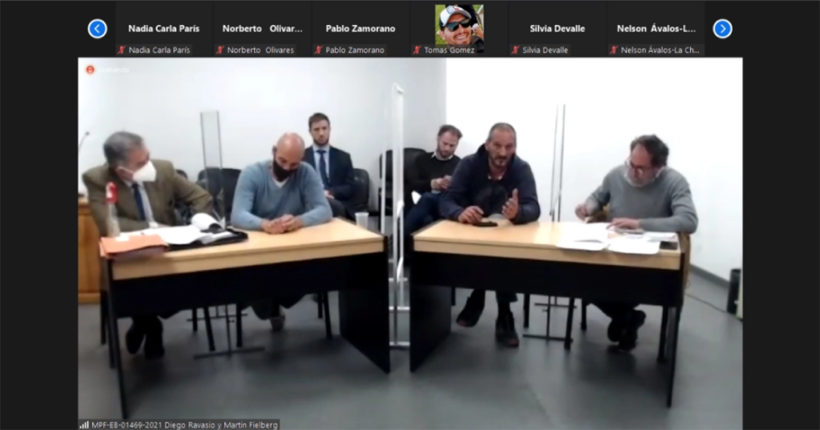The statement of the accused: three accidental shots, the Mapuche were like a “pack of dogs”, only one of the accused fired, there was a black lump that looked like a gun and the 22 carbine “kills cats”.
Today, during the afternoon, charges were brought against Diego Alejandro Ravasio and Martín Cruz Feilberg, for the crimes of co-perpetration of attempted murder and homicide, which ended the life of Elías Garay and mortally wounded Gonzalo Cabrera.
In this atypical hearing due to its length (three hours), Alejandro Ravasio and Martín Cruz Feilberg testified in their defence and answered questions from the prosecutors Francisco Arrien and Betiana Cendón, as well as from the plaintiffs, Ezequiel Palavecino and Andrea Reile.
Firstly, Diego Alejandro Ravasio testified, who said that they thought that there was nobody in the field (where Garay and Cabrera were shot) when they entered, that they went to look for firewood, that they work nearby, that they went there every day, that they had gone the day before, that the police had let them pass, that at one point they heard a stampede like a herd of horses, that they found themselves in front of seven or nine people, that they were threatened, that they were told that they were being threatened, that they had been told that they had been shot, that they had been told that they had been shot, that they were being threatened, that they had been told that they had been shot, that they had been told that they had been shot. That they threatened them, that they told them “Nobody is leaving here”, that they were afraid, that one person tried to take the gun from him, that he (Ravasio) threw it upwards and that the first shot escaped, that then they all rushed at him, that one of them grabbed his gun again, that when the person pulled it to his side, the second shot was fired. And then he (Ravasio) pulled to his side and the third shot was fired. In other words, the three shots were accidental. That only he had a .22 calibre gun (according to his defence lawyer Estanislao Cazaux, that gun only “kills cats”. He said it in these terms during the hearing). That Martin Feilberg had no weapon. That the people were like a “pack of dogs”, that they moved their hands up and down, that they seemed to be carrying a “black bundle”, similar to a gun.
On the other hand, Martin Cruz Feilberg supported these statements by affirming that he saw at least two guns and that if it had not been for his friend, who acted by shooting, he would have lost his life. And that he showed up on the fifth day to protect his family.
As the third part of the hearing, a four-month investigative process was agreed upon (not counting the month of January of the judicial fair). In addition, all the evidence present, (so far) in the case, read by Francisco Arrien (including the statement of Gonzalo Cabrera, as a direct witness to the shooting), was to be read.
Finally, in the fourth place, Judge Víctor Gangarrossa, understood that the legal conditions were in place to support the request for house arrest demanded by the prosecution and the defence lawyers. Arguing that both defendants, made evasive manoeuvres, not automatically presenting themselves to the police, fleeing, moving to another province, trying to cover with paint the number plate of the car with which they moved, presenting themselves to the justice system on the fifth day of the incident. In a context where one of the rifles is missing (according to the defence, the only one present at the scene) and the drone that the police were handling before the shots were fired.
In this sense, the prosecuting lawyer Ezequiel Palaccio warned at the same hearing that the versions of the two accused lack legitimacy, that their story is not very credible. That the defence lawyers (4) did not present any evidence to demand house arrest, that “they only have a story”. Meanwhile, the prosecuting lawyer Andrea Reile was very specific in warning that the people who are really afraid at the moment are precisely the victims: Gonzalo Cabrera – who is still hospitalised – and Elías Garay’s partner who had to move to another city to protect her safety.
Both accused will remain in the police station of Dina Huapi, until the definitive transfer to pre-trial detention is defined, until the investigative stage is completed and a trial finally begins, which, judging by many people, generates many suspicions given the speed and celerity with which the justice system acted.
The defendants acted alone, are there intellectual authors, how can the defence sustain the theory of a confrontation when no weapon was found in the possession of the Lof Quemquemtrew, where is the 22 calibre rifle and the drone that the police were handling, and what did Gonzalo Cabrera see? What did Gonzalo Cabrera see, based on the account of the defendants who claim that only one of them was carrying a weapon and that only one fired? How did racism operate in the willingness to shoot expressed by these defendants against the Lof Quemquemtrew community?






